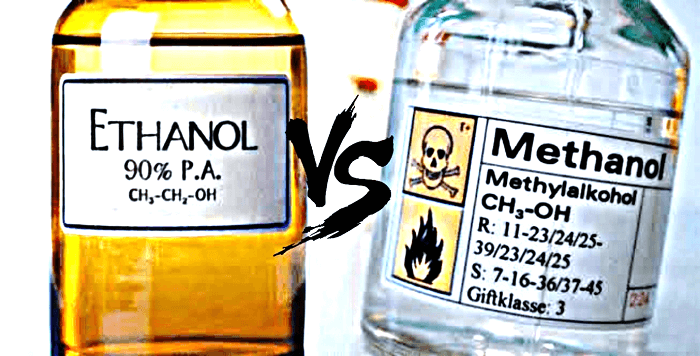Differences between Ethanol and MethanolAs we move towards a more sustainable future, alternative fuels such as ethanol and methanol are becoming increasingly popular. However, many people still find themselves confused about the key differences between the two. While both are alcohol-based fuels, they have distinct properties and uses that set them apart. Ethanol, for example, is commonly used as a biofuel and is often added to gasoline to reduce emissions. Methanol, on the other hand, is primarily used as an industrial solvent and as a feedstock to produce other chemicals. In this article, we will clear the confusion and delve deeper into the properties and uses of ethanol and methanol. Whether you're a student, or simply someone interested in the world of alternative fuels, this article will provide a clear understanding of the differences between these two important alcohols. So, let's get started! 
Chemical Composition and PropertiesAlthough both ethanol and methanol are alcohol-based fuels, they differ chemically. The chemical formula for ethanol is C2H5OH, which denotes that it contains one oxygen atom, two carbon atoms, and six hydrogen atoms. Conversely, methanol has one carbon atom, four hydrogen atoms, and one oxygen atom, or the chemical formula CH3OH. The characteristics of the two differ as a result of these changes in their chemical makeup. For instance, methanol is a colorless liquid with a boiling point of 64.7°C that is extremely combustible. Contrarily, ethanol is a colorless liquid with a boiling point of 78.4°C and is also quite combustible. These alcohols' capacity to dissolve in water is another crucial characteristic. Methanol and ethanol may both dissolve in any amount of water since they are both miscible with it. Even so, methanol may absorb more water from the atmosphere because it is more soluble in water than ethanol. Sources of Ethanol and MethanolThere are several methods for producing the kinds of alcohol ethanol and methanol. These are some typical sources for each: Sources of Ethanol
Sources of Methanol
It's significant to remember that while ethanol and methanol are both alcohols, they differ in terms of their traits and applications. While methanol is frequently utilised in the manufacturing of chemicals and polymers, ethanol is frequently employed as a fuel additive or solvent. Production ProcessesProduction Process of Ethanol:Alcohol is primarily produced by a fermentation process that turns carbohydrates from plant sources into ethanol. The following are the steps in the manufacturing of ethanol:
Production Process of Methanol:The following processes are involved in the manufacturing of methanol, which commonly uses natural gas or other hydrocarbons as a feedstock:
Methanol and Ethanol ApplicationsBoth ethanol and methanol are used in a wide range of industrial processes. Due to its potential to lessen hazardous emissions from gasoline and diesel engines, ethanol is frequently utilized as an additive in the fuel. Moreover, it can be utilized as a solvent in the creation of medicines, personal care goods, and cosmetics. Furthermore, the manufacture of chemicals like ethylene and acetic acid frequently uses ethanol as a feedstock. On the other hand, formaldehyde, acetic acid, and other compounds are typically produced using methanol as a chemical feedstock. It may also be used as a fuel in some situations, including race vehicles and high-performance boats, as well as a solvent in many other sectors. Methanol is not fit for human consumption because it is also utilized as a denaturant in the ethanol manufacturing process. Both methanol and ethanol have attracted interest recently as possible renewable energy sources. While methanol may be created from biomass and other renewable sources, ethanol can be made from renewable feedstocks like corn and sugarcane. These non-fossil fuels may become more crucial in supplying the world's energy needs as efforts are made to lessen reliance on fossil fuels. Health and Safety ConcernsIf not handled appropriately, ethanol and methanol may both be harmful. Being flammable, ethanol has the potential to irritate skin and harm eyes when it encounters them. Although methanol is far more dangerous than ethanol, it is also flammable. If consumed or breathed in excessive amounts, methanol can result in blindness or even death. Environmental ImpactThe production and use of ethanol and methanol can have both positive and negative environmental impacts.
In addition to the environmental impacts of production, the use of ethanol and methanol as fuels can also have environmental consequences. All kinds of alcohol have the potential to release air pollutants when burnt, especially in older or poorly maintained automobiles. Moreover, the production and use of ethanol and methanol may compete with the production of food, which may result in food shortages and higher food costs. Which Is Better: Ethanol or Methanol?Ethanol can be a better option if you're seeking a fuel that burns cleaner. Methanol could be a better option if you're seeking a fuel with a reduced carbon footprint that is more sustainable. In the end, the individual application and the accessibility of feedstocks will determine which alcohol should be used. Difference Table
ConclusionIn conclusion, while both ethanol and methanol are fuels based on alcohol, they differ in their characteristics and applications. Methanol is largely utilized as an industrial solvent and a feedstock for the manufacturing of chemicals, whereas ethanol is mostly used as a biofuel and a gasoline additive. If not handled appropriately, both alcohols may be harmful, although methanol is more poisonous than ethanol. It's crucial to take the application and the accessibility of feedstocks into account when deciding between the two alcohols.
Next TopicDifference between
|
 For Videos Join Our Youtube Channel: Join Now
For Videos Join Our Youtube Channel: Join Now
Feedback
- Send your Feedback to [email protected]
Help Others, Please Share










